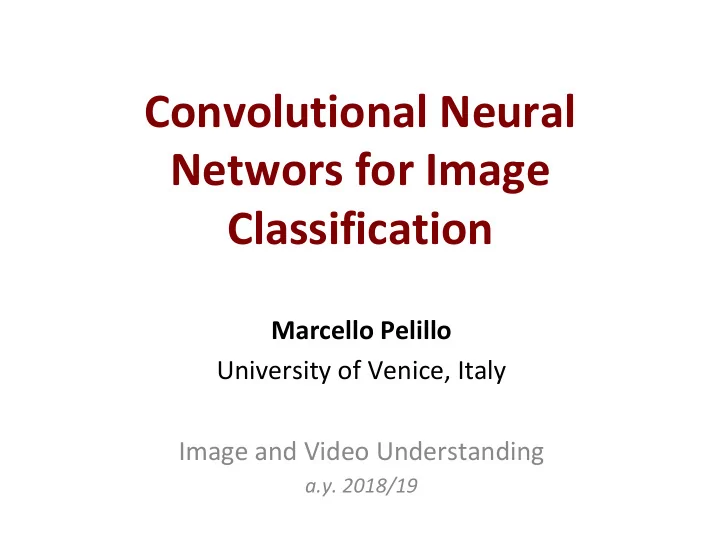

Convolutional Neural Networs for Image Classification Marcello Pelillo University of Venice, Italy Image and Video Understanding a.y. 2018/19
The Age of “Deep Learning”
The Deep Learning “Philosophy” • Learn a feature hierarchy all the way from pixels to classifier • Each layer extracts features from the output of previous layer • Train all layers jointly
Performance Improves with More Data
Old Idea … Why Now? 1. We have more data - from Lena to ImageNet. 2. We have more computing power, GPUs are really good at this. 3. Last but not least, we have new ideas
Image Classification Predict a single label (or a distribution over labels as shown here to indicate our confidence) for a given image. Images are 3-dimensional arrays of integers from 0 to 255, of size Width x Height x 3. The 3 represents the three color channels Red, Green, Blue. From: A. Karpathy
Challenges From: A. Karpathy
The Data-Driven Approach An example training set for four visual categories. In practice we may have thousands of categories and hundreds of thousands of images for each category. From: A. Karpathy
Inspiration from Biology
The Visual System as a Hierarchy of Feature Detectors
Convolution
Convolution
Mean Filters
Gaussian Filters
Gaussian Filters
The Effect of Gaussian Filters
The Effect of Gaussian Filters
Kernel Width Affects Scale
Edge detection
Edge detection
Using Convolution for Edge Detection
A Variety of Image Filters Laplacian of Gaussians (LoG) (Marr 1982)
A Variety of Image Filters Gabor filters (directional) (Daugman 1985)
A Variety of Image Filters From: M. Sebag
Traditional vs Deep Learning Approach From: M. Sebag
Convolutional Neural Networks (CNNs) (LeCun 1998) (Krizhevsky et al. 2012)
Fully- vs Locally-Connected Networks Fully-connected: 400,000 hidden units = 16 billion parameters Locally-connected: 400,000 hidden units 10 x 10 fields = 40 million parameters Local connections capture local dependencies From. M. A. Ranzato
Weight Sharing We can dramatically reduce the number of parameters by making one reasonable assumption: That if one feature is useful to compute at some spatial position (x1,y1), then it should also be useful to compute at a different position (x2,y2).
Using Several Trainable Filters Normally, several filters are packed together and learnt automatically during training
Pooling Max pooling is a way to simplify the network architecture, by downsampling the number of neurons resulting from filtering operations.
Combining Feature Extraction and Classification
AlexNet (2012) • 8 layers total • Trained on Imagenet Dataset (1000 categories, 1.2M training images, 150k test images)
AlexNet Architecture 1st layer: 96 kernels (11 x 11 x 3) • Normalized, pooled • 2nd layer: 256 kernels (5 x 5 x 48) • 650,000 neurons Normalized, pooled • 60 million parameters 3rd layer: 384 kernels (3 x 3 x 256) • 4th layer: 384 kernels (3 x 3 x 192) • 5th layer: 256 kernels (3 x 3 x 192) • Followed by 2 fully connected layers, 4096 neurons each • Followed by a 1000-way SoftMax layer •
Training on Multiple GPU’s
Output Layer: Softmax
Rectified Linear Units (ReLU’s) Problem: Sigmoid activation takes on values in (0,1). Propagating the gradient back to the initial layers, it tends to become 0 (vanishing gradient problem). From a practical perspective, this slows down the training procedure of the initial layers of the network.
Rectified Linear Units (ReLU’s)
Mini-batch Stochastic Gradient Descent Loop: 1. Sample a batch of data 2. Forward prop it through the graph, get loss 3. Backprop to calculate the gradients 4. Update the parameters using the gradient
Data Augmentation The easiest and most common method to reduce overfitting on image data is to artificially enlarge the dataset using label-preserving transformations AlexNet uses two forms of this data augmentation . The first form consists of generating image translations and • horizontal reflections. The second form consists of altering the intensities of the RGB • channels in training images.
Dropout Set to zero the output of each hidden neuron with probability 0.5. The neurons which are “dropped out” in this way do not contribute to the forward pass and do not participate in backpropagation. So every time an input is presented, the neural network samples a different architecture, but all these architectures share weights. Reduces complex co- adaptations of neurons, since a neuron cannot rely on the presence of particular other neurons.
ImageNet
ImageNet Challenges Deep learning!
ImageNet Challenge 2012
Revolution of Depth
A Hierarchy of Features From: B. Biggio
Layer 1 Each 3x3 block shows the top 9 patches for one filter
Layer 2
Layer 3
Layer 3
Feature Analysis A well-trained ConvNet is an excellent feature extractor . • Chop the network at desired layer and use the output as a feature • representation to train an SVM on some other dataset (Zeiler-Fergus 2013): Improve further by taking a pre-trained ConvNet and re-training it on a • different dataset (Fine tuning).
Other Success Stories of Deep Learning Today deep learning, in its several manifestations, is being applied in a variety of different domains besides computer vision, such as: • Speech recognition • Optical character recognition • Natural language processing • Autonomous driving • Game playing (e.g., Google’s AlphaGo) • …
References • http://neuralnetworksanddeeplearning.com • http://deeplearning.stanford.edu/tutorial/ • http://www.deeplearningbook.org/ • http://deeplearning.net/ Platforms: • Theano • PyTorch • TensorFlow • …
Recommend
More recommend